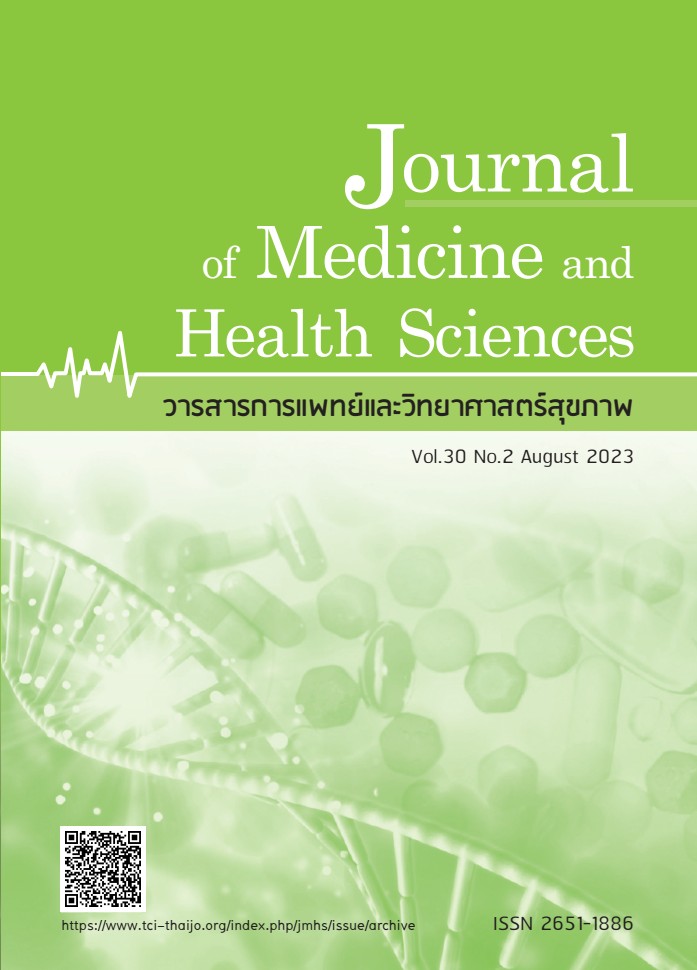Incidence of contrast-associated acute kidney injury among stage 3-5 CKD patients after the risk assessment form used before contrast enhanced computed tomography in the Medical Department of Somdejphrajaotaksin Maharaj Hospital
Keywords:
Contrast-associated acute kidney injury, chronic kidney disease, computed tomographyAbstract
The objective of this study is to study the incidence of Contrast-Associated Acute Kidney Injury (CA-AKI) after the use of a CT scan, MRI risk assessments in patients with Stage 3-5 CKD who underwent computed tomography by injecting an opaque substance with an initial eGFR level of less than 60 ml/min/1.73 m2 between June 1, 2020 and June 30, 2021, at the Internal Medicine Department of King Taksin Maharaj Hospital A total of 46 patients analyzed the data with a statistical package, using descriptive and inferential statistics, the Wilcoxon Signed-rank test set a statistical significance level of 0.05, with the study finding a 10.9% incidence of CA-AKI, with the CA-AKI group having an average age of 66 years, and caused by congestive heart failure and chronic kidney disease. The average creatinine serum baseline is 2.21 mg/dl. The average eGFR baseline was 37.85 ml/min/1.73 m2, and 4 out of 5 patients with CA-AKI died in hospital, and when comparing the serum creatinine median of the sample, it was found that the group that obtained only normal saline had a median post-exposure of opaque substances equal to 1.65 mg/dl. Before exposure to opaque substances equal to 3.55 mg/dl. The median decrease was different at a statistically significant level (p-value < 0.05). There were 18 cases and an average percentage increase of 28.2%.
References
Kidney Disease Improving Global Outcomes (KDIGO). Clinical practice guideline for acute kidney injury. Kidney Int Suppl 2012;2:1-141.
Barrett BJ, Shamseddin MK. Approaches to contrast-induced nephropathy. US Nephrology 2009;4:36-40.
Modi K, Padala SA, Gupta M. Contrast-induced nephropathy [Internet]. StatPearls. StatPearls Publishing, Treasure Island (FL); 2020 [cited 2021 Jul 12]. Available from: https://europepmc.org/article/nbk/nbk448066
Jabara R, Gadesam RR, Pendyala LK, et al. Impact of the definition utilized on the rate of contrast-induce nephropathy in percutaneous coronary intervention. Am J Cardiol 2009;103:1657-62
Nash K, Hafeez A, Hou S. Hospital-acquired renal insufficiency. Am J Kidney Dis 2002;39:930-6.
Silvain J, Nguyen LS, Spagnoli V, et al. Contrast-induced acute kidney injury and mortality in ST elevation myocardial infarction treated with primary percutaneous coronary intervention. Heart 2018;104(9):767-72.
Kang X, Hu DY, Li CB, et al. N-acetylcysteine for the prevention of contrast-induce nephropathy in patients with pre-existing renal insufficiency or diabetes: a systemic review and meta-analysis. Ren Fail 2015;37(10):297-303.
Liu Y, Hong D, Wang AY, et al. Effect of intravenous hydration on risk of contrast induce nephropathy and in-hospital mortality in STEMI patients undergoing primary percutaneous coronary intervention: a systematic review and meta-analysis of randomized controlled trials. BMC Cardiovasc Disord 2019;19(1):87.
Brown JR, DeVries JT, Piper WD, Robb JF, Hearne MJ, Ver Lee PM, et al. Serious renal dysfunction after percutaneous coronary interventions can be predicted. Am Heart J 2008;155(2):260-6.
Mehran R, Aymong ED, Nikolsky E, et al. A simple risk score for prediction of contrast-induced nephropathy after percutaneous coronary intervention: development and initial validation. J Am Coll Cardiol 2004;44(7):1393-9.
Pannu N, Wiebe N, Tonelli M. Prophylaxis strategies for contrast-induced nephropathy. JAMA 2006;295(23):2765-79.
Rudnick MR, Kesselheim A, Goldfarb S. Contrast-induced nephropathy: how it develops, how to prevent it. Cleve Clin J Med 2006;73:75-80.
Subramaniam RM, Cuervo CS, Wilson RF, et al. Effectiveness of prevention strategies for contrast-induced nephropathy. Ann Intern Med 2016;164(6):406-16.
Downloads
Published
How to Cite
Issue
Section
License

This work is licensed under a Creative Commons Attribution-NonCommercial-NoDerivatives 4.0 International License.



